Four Knights Game: Scotch Variation

Four Knights Game – Scotch Variation: Opening trends change all the time. People play whatever is played the most at the top level, whether that opening suits them or not.
Many players like to follow the latest trends, dictated by the leading experts in the opening.
While there is nothing wrong with this, if you are an improving player, you should try to find a good, solid set-up that suits your style, regardless of the latest opening trends.
The Italian and the Ruy Lopez are the main lines against 1…e5 and they are both very good, solid openings. They both promise a long, fighting game, with chances for both sides.
But if you are looking for a solid and reliable alternative against 1…e5, the Scotch Variation of the Four Knights Opening is worth looking into.
Advantages of the Four Knights Game
The reputation of this line has been that black generally equalizes easily. However, the white’s position is full of resources and there are real possibilities of outplaying your opponent. There are a few advantages to playing this opening:
1. Scotch Variation is not mainline and it can come as a surprise to your opponent
When learning 1…e5, most players will focus on the main replies from white and will make sure that they know how to play against them.
The not-so-popular lines are often ignored or studied less – “nobody’s going to play this anyway”. The Four Knights Scotch has actually been used quite a lot as a surprise weapon even by Grandmasters.
A quick search in the database will return a great number of the Scotch played in rapid and blitz games by top players, with very good results! Young stars as Nodirbek Abdusattorov or Jeffrey Xiong have both used it occasionally as a blitz weapon.
2. The amount of theory you’ll have to learn in Four Knights Game is considerably less than in other openings
Its character is also less forced. White has options and there is plenty of room for innovation. The resulting middlegames admit different approaches and you can go for different plans. It is also a line that gives your opponent fewer options. Its main line transposes to one of the lines in the Scotch Opening (1.e4 – e5 2.Nf3 – Nc6 3.d4), but here, after 3…exd4 4.Nxd4 black has a few options that can take the game in a completely different direction. With the Four Knights Scotch, you are more or less forcing your opponent to go for the main set-up.
3. Scotch Variation creates a positional imbalance
In the main line of the Four Knights Scotch black will usually end up with hanging pawns in the center. There is usually some activity to compensate for this, but white has found good ways of putting pressure on black’s structure and using its weaknesses.
4. In Four Knights Game white isn’t taking any major risks
This is an almost risk-free opening for white, which is quite a nice feeling. You are trying to outplay your opponent slowly and, if he plays all the good moves, the position will still be equal.
But if black can’t find the best replies, then white will usually get an edge.
This isn’t an opening that will give you wild positions, where you can play for tactics or any attacking ideas. White usually gets comfortable positions, where he can put long-term pressure on black’s position.
5. Many times, the middlegames that arise from its main line will take you to the endgame.
If you are a player who likes unbalanced endgames, then this line is for you. A player who is comfortable playing endgames with rooks + minor pieces will certainly feel in his element with this opening choice.
Black’s Options in Four Knights Game Scotch Variation
Let’s take a brief look at black’s options. The Four Knights Scotch arises after the moves 1.e4 e5 2.Nf3 Nc6 3.Nc3 Nf6 4.d4:
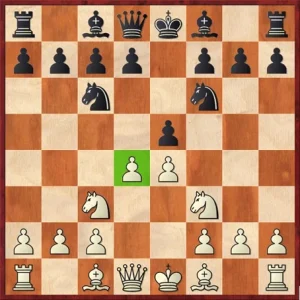
Here, by far the most popular reply from the black is 4…exd4. Anything else allows either the capture on e5 or the advance of the d4 pawn to d5. The main choice for black comes after move 5.Nxd4.
Black’s main choice and the move that will transpose to the Scotch Opening is 5…Bb4:
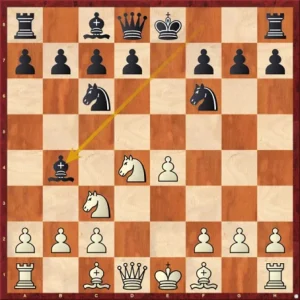
Now white follows with 6.Nxc6 bxc6 7.Bd3 (defending the e4 pawn) and black will strike in the center with 7…d5.
After 8.exd5 exd5 9.0-0 0-0 we reach the main position of this opening, where white has many interesting choices:
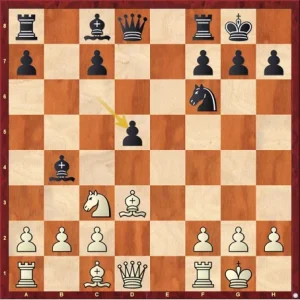
Here you can do a quick search and choose a move that you like most.
One interesting idea is to play 10.h3 here, followed by Qf3 and Bf4. One main plan after this is to follow up with Ne2 (planning on going either to d4 or f4, after the trade of the dark-squared bishops).
There are many interesting games to study here, but white will generally try to use the weak dark squares in black’s position. The advance of the hanging pawns will create new weaknesses, which is why sometimes white will double the rooks on the d file. The following game demonstrates this:
Four Knights Game – 5…Bc5
The second most popular move after white’s 5.Nxd4 is 5…Bc5:
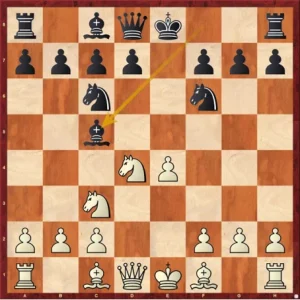
Again, white has options.
The most logical continuation here and the main line is 6.Be3, defending the knight and preparing to play Qd2 and 0-0-0, with a fighting position.
White has good attacking prospects on the kingside, while black’s attack doesn’t seem to be that fast on the queenside.
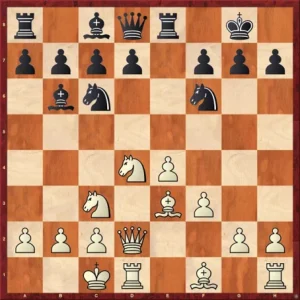
This is our main position, where white is ready to play g4. The only critical move for black here is …d5, but white will still get an edge.
The other interesting option for white on move 6 is Nb3 when white’s idea involves castling long as well. The development will now be with Qe2, Bg5 followed by 0-0-0:
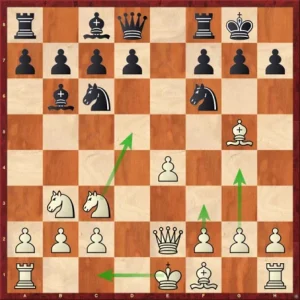
White’s plan is similar – to play f3, followed by g4. To this, white also has the additional idea of jumping with the knight to d5, which will put pressure on f6 and will force black to accept doubled pawns on the f file.
Capturing the knight on d4 on move 5 will basically help white achieve his plan. After 6.Qxd4 you already know what’s coming – Bg5 and 0-0-0.
White already has an edge and a very comfortable position. A good continuation after 6…d6 7.Bg5 Be7 8.0-0-0 0-0 is 9.e5:
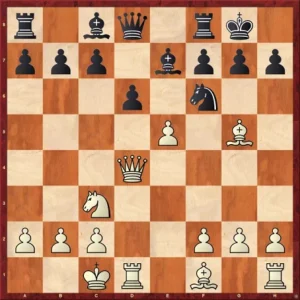
White has a lead in development and better-coordinated pieces.
Four Knights Game – 5…Nxe4
Finally, one option for black that you should be aware of is 5…Nxe4 (yes, sacrificing pieces):
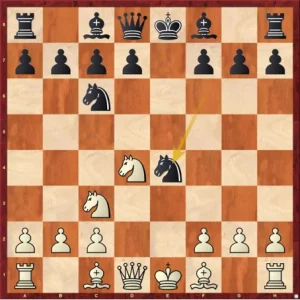
Black’s idea is that after 6.Nxe4 Qe7 will win the piece back. The e4 knight is pinned and, due to the threat over the d4 knight, white doesn’t have a way of keeping it.
However, there are several good options for white in this position. 7.f3 f5 is one of them, but the following move played by Dubov contains a lot of venoms:
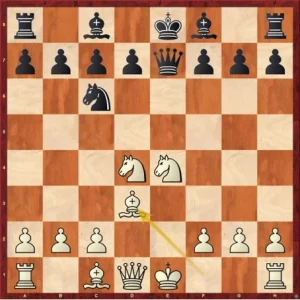
7.Bd3 defends the e4 knight. Black is forced to capture the one on d4 and now, after 0-0, white is down a pawn, but has big compensation.
Black will have to waste another move to get the unprotected knight out of e6, while Re1 (pointing at the King) and Qh5 are coming. In one blitz game, black replied with 7…Nxd4 8.0-0 Ne6 9.Re1 d5 10.Ng5 h6 11.Qh5:
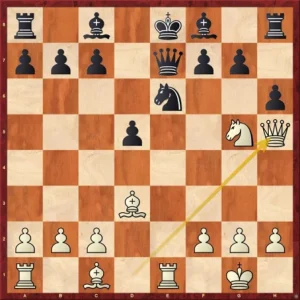
This position is already difficult for black, who in the game couldn’t find a good defense against the threat of Nxf7 followed by Bg6. He played 11…hxg5 and after 12.Qxh8 white was up an exchange, with a very good position. Here’s the full game:
Four Knights Game: Scotch Variation – Conclusion
In conclusion, the Four Knight Scotch is a fighting opening, that can pose black real problems.
With the best play, the position should be equal, but white still has some uncomfortable ideas to provoke black to make mistakes.



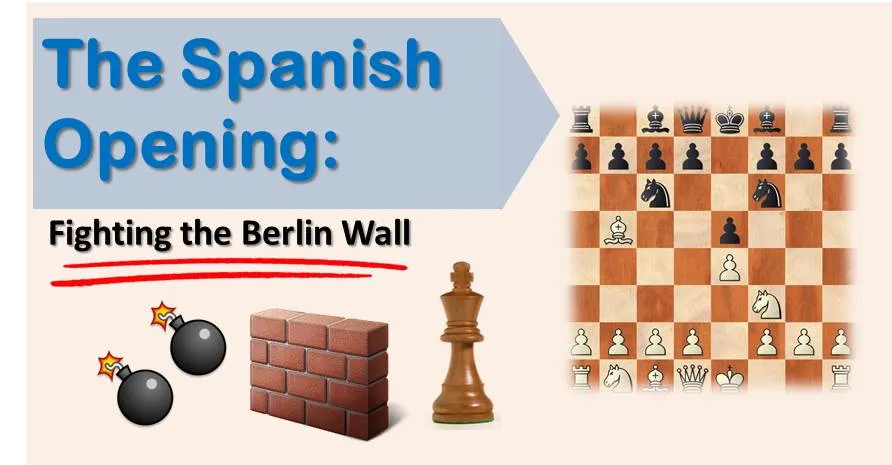






Comments: